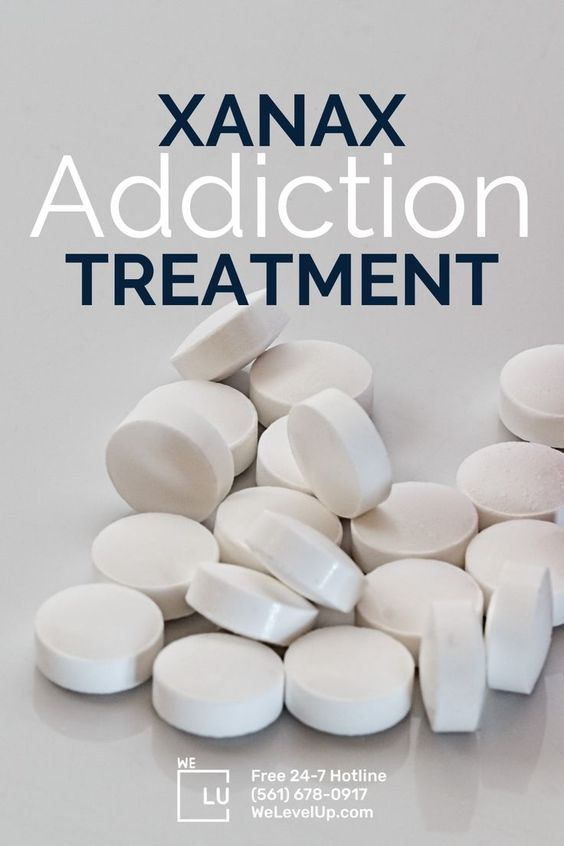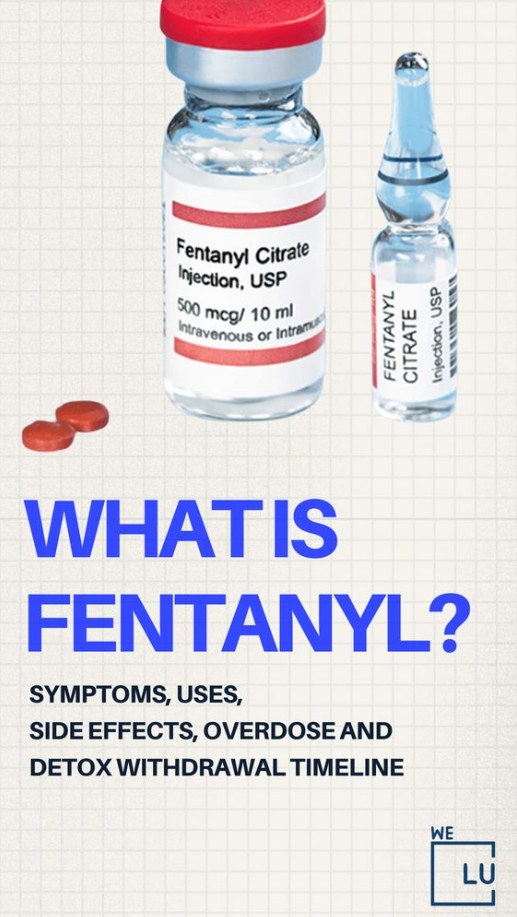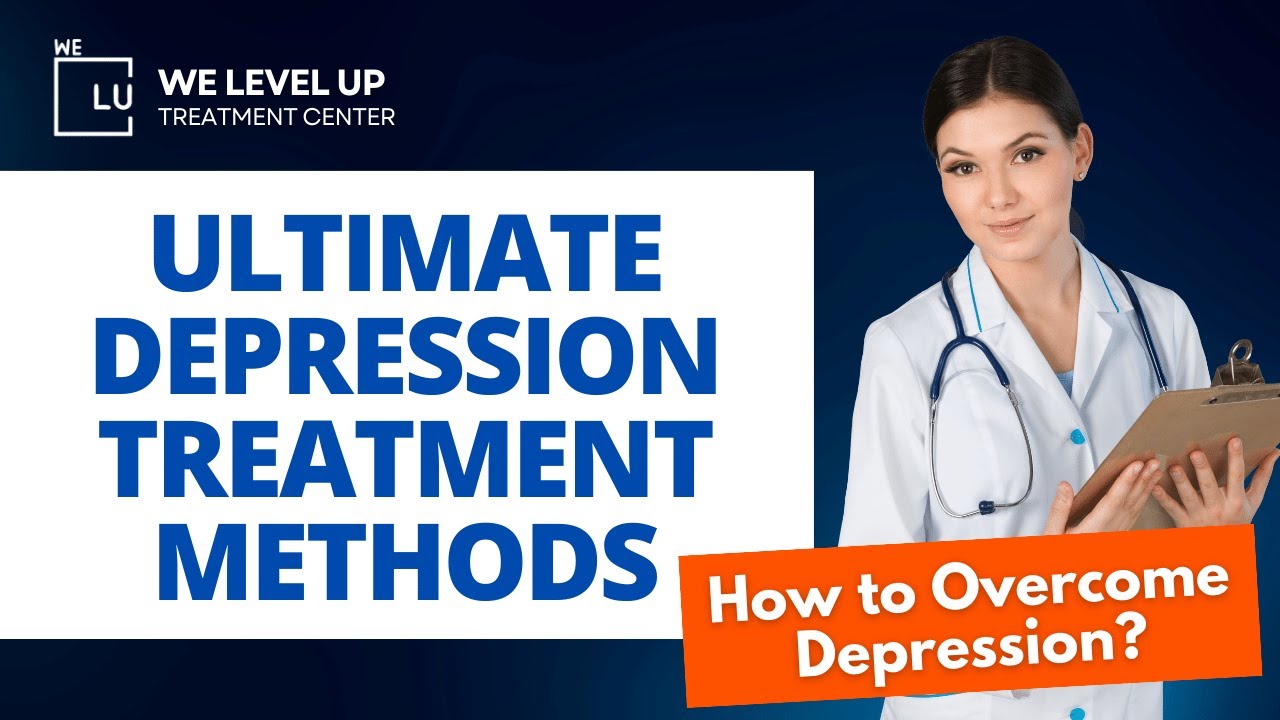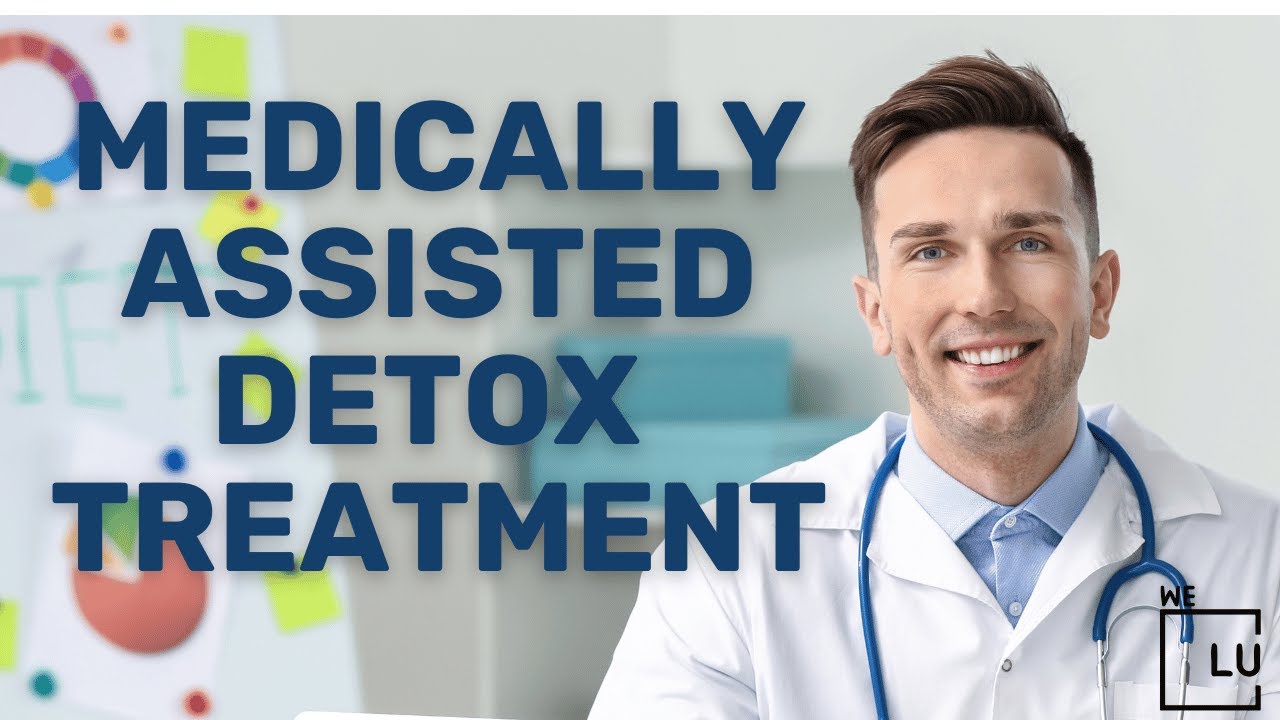Healthcare professionals usually prescribe skeletal muscle relaxants (SMRs) such as Flexeril (cyclobenzaprine) and Robaxin (methocarbamol) to treat back pain and sprains or strains in the muscles.
Methocarbamol vs Cyclobenzaprine function similarly by impacting the central nervous system (CNS). These drugs, which are classified as antispasmodics, help treat acute, excruciating musculoskeletal disorders that cause pain and spasms in the muscles. They also have comparable adverse effects, such as fatigue and vertigo.
If you or someone you know is suffering from Cyclobenzaprine and Methocarbamol addiction, We Level Up Treatment Centers can help. Speak with our hotline specialists and discover the support and professional-accredited addiction treatment programs we offer.
What Is Methocarbamol?
Methocarbamol is a muscle relaxant medication used to alleviate muscle spasms and discomfort. It is often prescribed as part of a comprehensive treatment plan that includes rest, physical therapy, and other measures to relieve musculoskeletal conditions. Methocarbamol is believed to work by affecting the central nervous system, specifically by depressing nerve activity and decreasing muscle tone.
This medication is commonly used to treat muscle strains, sprains, and injuries. It is not typically used as the sole treatment but as an adjunct to rest and physical therapy. Methocarbamol is available in oral tablet form and is usually taken several times daily, as directed by a healthcare professional.
What Is Cyclobenzaprine?
Cyclobenzaprine is a muscle relaxant medication that relieves muscle spasms and discomfort associated with acute musculoskeletal conditions, such as muscle strains and sprains. It is often prescribed as part of a treatment plan that includes rest and physical therapy.
Cyclobenzaprine works by affecting nerve impulses or signals in the brain that are involved in muscle movement. It is believed to have a calming effect on the central nervous system, leading to muscle relaxation.
This medication is typically taken orally as tablets or extended-release capsules. The dosage and duration of treatment depend on the specific condition and the individual patient’s response to the medication. Make sure to follow the prescribed dosage and instructions a healthcare professional provides.
Methocarbamol vs Cyclobenzaprine
Robaxin
Robaxin, or methocarbamol, entered the market in the 1960s. While its exact mode of action remains uncertain, Robaxin is thought to alleviate discomfort primarily due to its soothing effects rather than directly affecting muscle contractions.
Available as a brand name or generic drug, Robaxin is offered in injection form and as 500 mg or 750 mg oral tablets. Initially, individuals prescribed Robaxin tablets are advised to take two or three tablets four times a day, followed by a recommended dosage of one or two tablets three to four times daily or more.
Flexeril
Flexeril: Flexeril received FDA approval in the 1970s. It chiefly acts on the central nervous system (CNS) by targeting the brain stem and spinal cord to diminish motor activity. Structurally akin to tricyclic antidepressants, Flexeril shares similar side effects, such as dry mouth and sedation.
Known by its generic name, cyclobenzaprine, the brand-name Flexeril has been discontinued. However, cyclobenzaprine is available under two other brand names: Amrix (extended-release) and Fexmid (immediate-release). The extended-release tablet is designed for once-daily intake.
Methocarbamol And Cyclobenzaprine Differences
Methocarbamol and cyclobenzaprine are muscle relaxants commonly used to treat musculoskeletal conditions, but they differ in their mechanisms of action, side effects, and dosing.
1. Mechanism of Action:
- Methocarbamol: Its exact mechanism of action is not well understood. However, it is believed to depress nerve activity in the spinal cord and affect the central nervous system to produce muscle relaxation.
- Cyclobenzaprine: It affects nerve impulses or signals in the brain, leading to muscle relaxation. It has a structure similar to tricyclic antidepressants and shares some of their pharmacological effects.
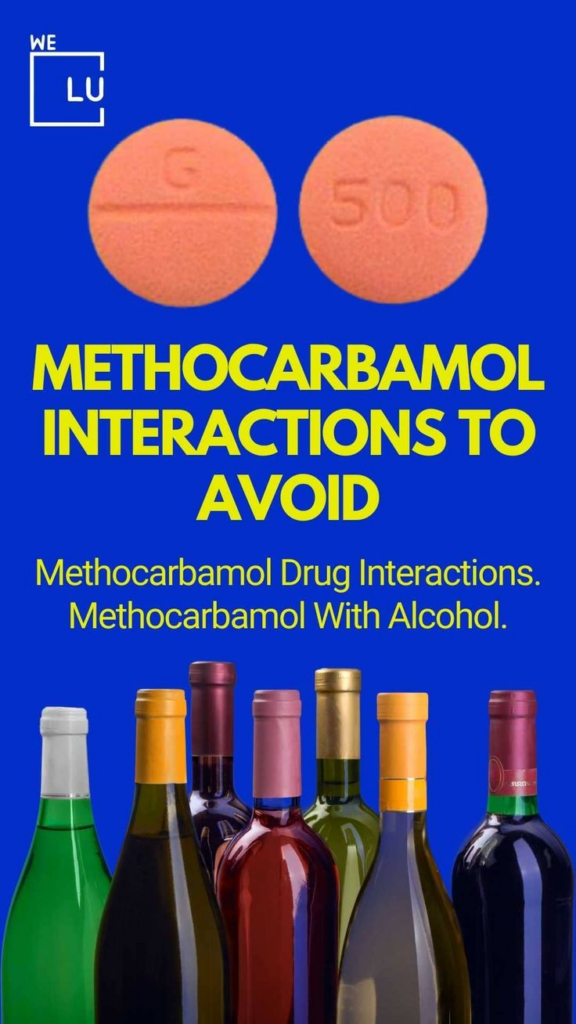
Skip To:
Learn More:
- How Long Does Morphine Stay in Your System?
- Morphine Withdrawal Symptoms, Timeline, and Detox Treatment
- Opiate Withdrawal
- Opioid Withdrawal Timeline
- Opioid Withdrawal Symptoms
- Fentanyl Detox Timeline and Withdrawal Symptoms
- Fentanyl Detox Timeline and Withdrawal Symptoms
- How Strong is Fentanyl? Fentanyl vs Other Opioids
- What is a Lethal Dose of Fentanyl? Deadly Fentanyl Dose Warnings
- What Is Fentanyl?
- Fentanyl Withdrawal
- Hydrocodone vs Oxycodone, Unveiling The Differences
2. Side Effects:
- Methocarbamol: Common side effects may include drowsiness, dizziness, and lightheadedness. It tends to have fewer anticholinergic side effects compared to cyclobenzaprine.
- Cyclobenzaprine: Common side effects include drowsiness, dry mouth, and dizziness. It can have more pronounced anticholinergic effects, such as blurred vision and constipation.
3. Dosage and Administration:
- Methocarbamol: It is typically taken several times a day as oral tablets. The dosage depends on the specific condition being treated and the individual patient.
- Cyclobenzaprine: It is usually taken in tablet or extended-release capsule form. The dosage and duration of treatment depend on the specific condition and the patient’s response to the medication.
4. Interactions:
- Both medications can interact with other drugs, so inform your healthcare provider about all your medicines, supplements, and herbal products.
5. Precautions:
- Both medications may cause drowsiness and impair your ability to perform tasks that require alertness, such as driving. Avoid alcohol and certain activities until you know how these medications affect you.
| Characteristic | Robaxin (Methocarbamol) | Flexeril (Cyclobenzaprine) |
|---|---|---|
| Drug Class | Muscle relaxant, Antispasmodic | Muscle relaxant, Antispasmodic |
| Brand/Generic Status | Branded and generic versions are available | Branded and generic versions available |
| Generic Name | Methocarbamol | Cyclobenzaprine |
| Form(s) | Oral tablet, Injection | Oral tablet, Oral capsule (extended-release) |
| Standard Dosage | Initial: 1500 mg 4 times daily | Immediate-release tablets: 5 mg three times daily. The dose may be increased to 10 mg 3 times daily. Extended-release capsules: 15 mg once daily. The dose may be increased to 30 mg once daily. |
| Typical Treatment Duration | Short-term or long-term treatment as directed by your doctor | No more than 2 to 3 weeks |
| Usual Patient Population | Adults and young adults ages 16 years or older | Adults and young adults ages 15 years or older |
Get Help. Get Better. Get Your Life Back.
Searching for Accredited Drug and Alcohol Rehab Centers Near You? We Level Up Texas Is Opening Soon!
Even if you have failed previously and relapsed, or are in the middle of a difficult crisis, we stand ready to support you. Our trusted behavioral health specialists will not give up on you. When you feel ready or just want someone to speak to about therapy alternatives to change your life call us. Even if we cannot assist you, we will lead you to wherever you can get support. There is no obligation. Call our network hotline today.
FREE Addiction Hotline – Call 24/7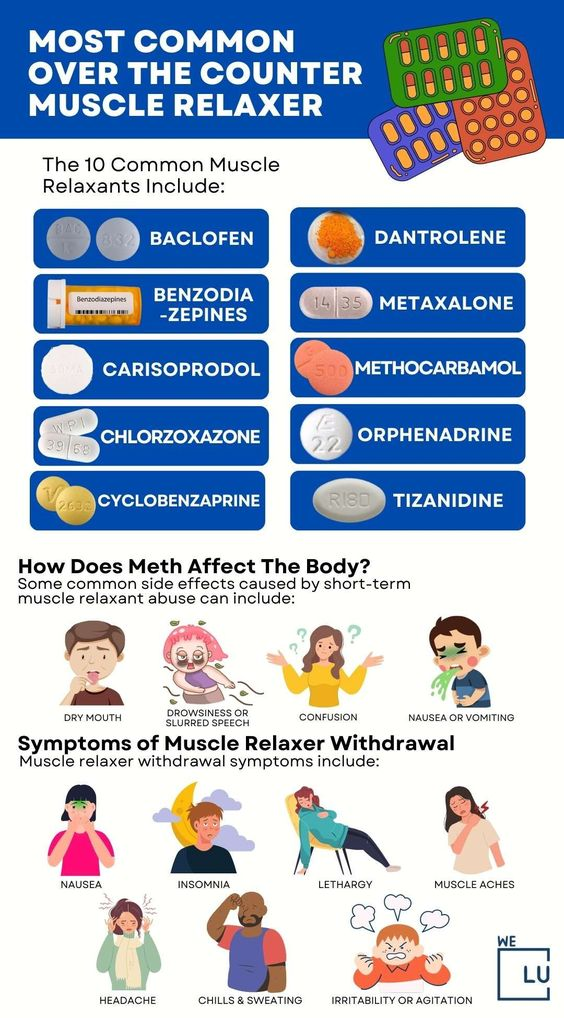
Which Is Stronger Methocarbamol Or Cyclobenzaprine?
Cyclobenzaprine vs Methocarbamol: Which Muscle Relaxant is More Effective?
Determining the more effective muscle relaxant between Robaxin and Flexeril depends on individual response and specific conditions.
Flexeril, extensively studied among muscle relaxants, holds more research-backed evidence supporting its efficacy. Systematic reviews have shown that various muscle relaxants, including Flexeril, demonstrate comparable effectiveness. Other examined relaxants encompass metaxalone, baclofen, tizanidine, orphenadrine, and chlorzoxazone.
In a direct comparison between methocarbamol and cyclobenzaprine, no significant disparity emerged in addressing muscle spasms or tenderness. However, patients reported slightly better-localized pain relief with cyclobenzaprine (48% vs. 40%). Notably, cyclobenzaprine usage increased drowsiness (58% vs. 10%).
Clinical trials pitted cyclobenzaprine against Valium (diazepam) and Soma (carisoprodol), revealing a similar efficacy of cyclobenzaprine in treating acute low back pain.
Seek professional medical advice for personalized treatment recommendations tailored to your health profile. A doctor’s comprehensive assessment can assist in identifying the preferred option based on individual medical history.
Get Help. Get Better. Get Your Life Back.
Searching for Accredited Drug and Alcohol Rehab Centers Near You? We Level Up Texas Is Opening Soon!
Even if you have failed previously and relapsed, or are in the middle of a difficult crisis, we stand ready to support you. Our trusted behavioral health specialists will not give up on you. When you feel ready or just want someone to speak to about therapy alternatives to change your life call us. Even if we cannot assist you, we will lead you to wherever you can get support. There is no obligation. Call our network hotline today.
FREE Addiction Hotline – Call 24/7When To Use Cyclobenzaprine Or Methocarbamol?
The choice between cyclobenzaprine (Flexeril) and methocarbamol (Robaxin) often depends on the specific musculoskeletal condition being treated, individual patient characteristics, and the healthcare provider’s preferences. Here are some general guidelines on when these medications might be used:
- Cyclobenzaprine (Flexeril):
- Conditions: Cyclobenzaprine is commonly used to treat acute muscle spasms and pain associated with musculoskeletal conditions such as muscle strains and sprains.
- Duration of Use: It is generally prescribed for short-term use, typically no more than 2 to 3 weeks.
- Usual Patient Population: Adults and young adults ages 15 years or older.
- Methocarbamol (Robaxin):
- Conditions: Methocarbamol is also used to relieve muscle spasms and discomfort associated with musculoskeletal conditions, including muscle strains and sprains.
- Duration of Use: It can be used for short-term or long-term treatment as directed by a healthcare provider.
- Usual Patient Population: Adults and young adults ages 16 years or older.
Effects Of Muscle Relaxers
Muscle relaxers, also known as muscle relaxants, can have various effects on the body, primarily targeting the musculoskeletal and central nervous systems. Here are some general effects:
1. Muscle Relaxation: The primary purpose of muscle relaxers is to reduce muscle spasms, tension, and stiffness. They do this by affecting the central nervous system, which can lead to a calming effect on muscle activity.
2. Sedation: Many muscle relaxants can cause drowsiness and sedation. This side effect is particularly common, and individuals are often advised not to operate heavy machinery or engage in activities that require alertness until they know how the medication affects them.
3. Central Nervous System Depression: Muscle relaxers can depress the central nervous system. This can result in a general reduction of nerve activity, leading to relaxation of both voluntary and involuntary muscles.
4. Dizziness and Lightheadedness: Some individuals may experience dizziness or lightheadedness as a side effect of muscle relaxers. This can be more pronounced when changing positions, such as standing up quickly.
5. Dry Mouth: Dry mouth is a common side effect of certain muscle relaxants, particularly those with anticholinergic properties. Anticholinergic effects can also include blurred vision and constipation.
6. Coordination Impairment: Muscle relaxers can affect coordination and motor skills, which is another reason why activities that require concentration and coordination should be approached with caution while taking these medications.
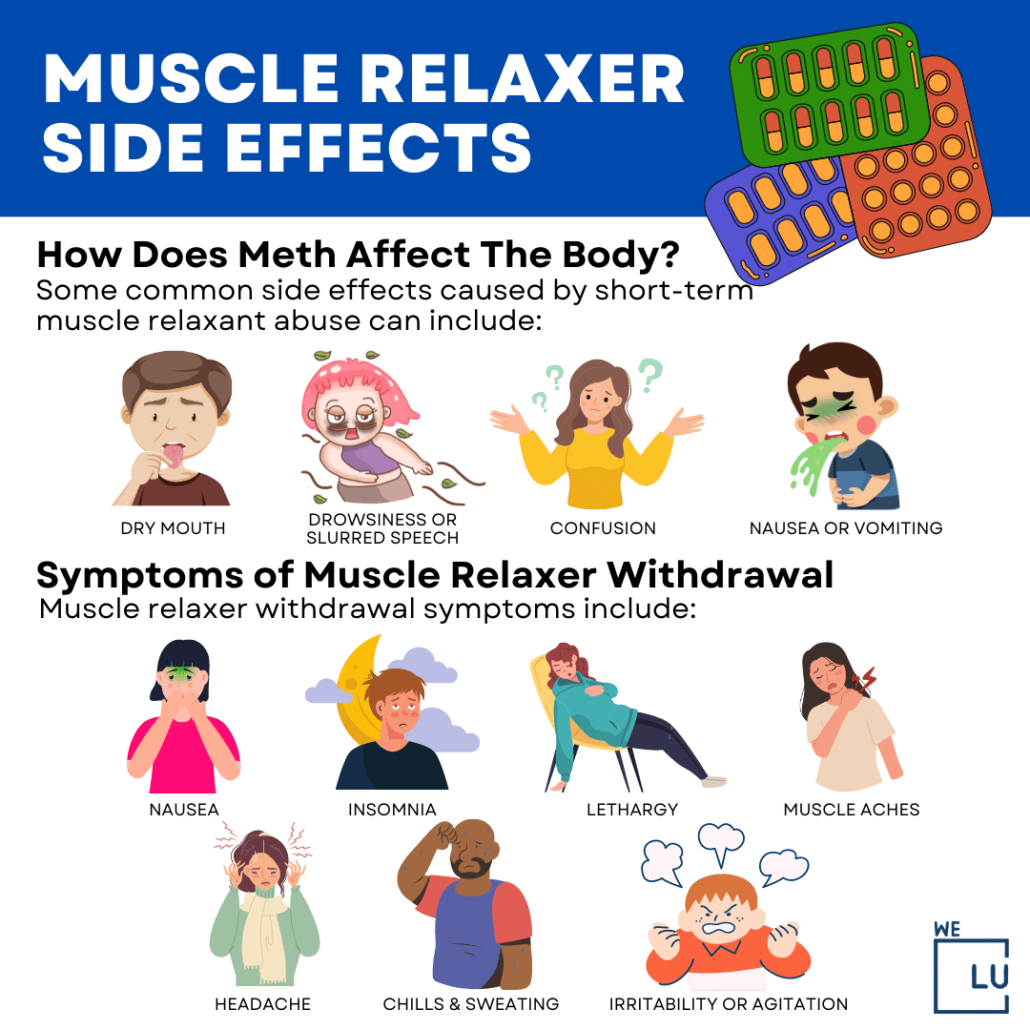
7. Potential Interactions: Muscle relaxants may interact with other medications, increasing the risk of side effects or diminishing the effectiveness of one or both drugs. Inform your healthcare providers about all medicines being taken.
8. Short-Term or Long-Term Use: Depending on the specific medication, muscle relaxers may be prescribed for short-term relief of acute muscle spasms or longer-term use in chronic conditions. The duration of use is determined by the nature of the musculoskeletal issue and the overall treatment plan.
Start a New Life
Begin with a free call to an addiction & behavioral health treatment advisor. Learn more about our dual-diagnosis programs. The We Level Up treatment center network delivers recovery programs that vary by each treatment facility. Call to learn more.
- Personalized Care
- Caring Accountable Staff
- World-class Amenities
- Licensed & Accredited
- Renowned w/ 100s 5-Star Reviews
We’ll Call You
Cyclobenzaprine Addiction Statistics
Understanding the scope and impact of Flexeril (cyclobenzaprine) addiction is essential for addressing this issue. By examining Flexeril addiction statistics, we can gain insights into the prevalence, trends, and consequences associated with the misuse and abuse of this medication. These statistics shed light on the challenges faced by individuals and communities affected by Flexeril addiction, highlighting the need for awareness, prevention, and effective treatment strategies.
0.2%
Roughly 0.2% of individuals aged 12 and older in the US reported misusing cyclobenzaprine (the generic name for Flexeril) in 2018.
Source: SAMHSA
2003 to 2015
JAMA Network Open found that the misuse of muscle relaxants, including cyclobenzaprine, increased significantly during this period.
Source: JAMA Network Open
79.1%
From 2004 to 2015, cyclobenzaprine-related emergency department visits increased by 79.1%.
Source: Journal of Addiction Medicine
Opening Soon! First-Class Facilities & Amenities
World-Class High-Quality Addiction & Mental Health Rehabilitation Treatment
Coming Soon! Rehab Centers TourRenowned Addiction Centers. Serene Private Facilities. Inpatient Rehab Programs Vary.
FREE Addiction Hotline – Call 24/7Proven recovery success experience, backed by a Team with History of:
- 15+ Years Experience
- 100s of 5-Star Reviews
- 10K+ Recovery Successes
- Low Patient to Therapist Ratio
- Onsite Medical Detox Center
- Comprehensive Dual-Diagnosis Treatment
- Complimentary Family & Alumni Programs
- Coaching, Recovery & Personal Development Events
Muscle Relaxers Addiction Treatment
Professional intervention for individuals misusing Flexeril, whether in combination with other substances or on its own, is crucial to help them overcome compulsive use and improve overall health and well-being.
Given that the withdrawal symptoms related to Flexeril are typically mild, intense medical detoxification might not be essential. Nonetheless, individuals should seek advice from a healthcare professional or treatment expert to determine the most appropriate action.
Even though medical detox may not be mandatory, seeking professional detox services provides structured care, comfort, and essential support to facilitate the initial stages of recovery.
If other substance dependencies, such as alcohol, opioids, or sedatives, are present, medical detox may be required.
Apart from detoxification, comprehensive substance abuse treatment could encompass the following:
- Participation in inpatient/residential or outpatient drug addiction recovery programs with a focus on targeted recovery efforts.
- Engaging in behavioral therapies, counseling, addiction education, support group involvement (like 12-step programs), and learning relapse prevention strategies.
- Involving the support and understanding of family, friends, and the community during rehabilitation. This backing can significantly aid individuals in achieving and maintaining recovery.
Although Flexeril is an unscheduled drug with a relatively low potential for abuse, continuous and compulsive patterns of use can lead to severe consequences.
Individuals who receive empathetic support for their Flexeril misuse as part of professional treatment have the opportunity to make positive changes and successfully eliminate the drug from their lives.
Why Choose We Level Up Treatment Center?
At We Level Up Treatment Center, our dedicated team of professionals is committed to guiding you through every step of your recovery journey. We prioritize your well-being and provide a nurturing environment conducive to healing and growth.
Take the first step towards recovery today. Contact us to begin your journey to a drug-free life. You don’t have to face addiction alone—we are here to help you reclaim control and achieve lasting sobriety.
Start a New Life
Begin with a free call to an addiction & behavioral health treatment advisor. Learn more about our dual-diagnosis programs. The We Level Up treatment center network delivers recovery programs that vary by each treatment facility. Call to learn more.
- Personalized Care
- Caring Accountable Staff
- World-class Amenities
- Licensed & Accredited
- Renowned w/ 100s 5-Star Reviews
We’ll Call You
Muscle Relaxers Cyclobenzaprine, Soma, Baclofen, their Side Effects, Warnings, Types & Risks
Search We Level Up TX Methocarbamol vs Cyclobenzaprine, Similarities & Differences Topics & Resources
Sources
- Khan I, Kahwaji CI. Cyclobenzaprine. [Updated 2023 Aug 28]. In: StatPearls [Internet]. Treasure Island (FL): StatPearls Publishing; 2023 Jan-. Available from: https://www.ncbi.nlm.nih.gov/books/NBK513362/ methocarbamol vs cyclobenzaprine
- Medline Plus – Cyclobenzaprine – https://medlineplus.gov/druginfo/meds/a682514.html
- FDA Access Data – Flexeril (Cyclobenzaprine) – https://www.accessdata.fda.gov/drugsatfda_docs/label/2003/017821s045lbl.pdf methocarbamol vs cyclobenzaprine
- DEA – Cyclobenzaprine – https://www.deadiversion.usdoj.gov/drug_chem_info/cyclobenzaprine.pdf methocarbamol vs cyclobenzaprine
- Sibrack J, Hammer R. Methocarbamol. [Updated 2022 Nov 14]. In: StatPearls [Internet]. Treasure Island (FL): StatPearls Publishing; 2023 Jan-. Available from: https://www.ncbi.nlm.nih.gov/books/NBK565868/ methocarbamol vs cyclobenzaprine
- Medline Plus – Methocarbamol – https://medlineplus.gov/druginfo/meds/a682579.html
- See S, Ginzburg R. Choosing a skeletal muscle relaxant. Am Fam Physician. 2008 Aug 1;78(3):365-70. PMID: 18711953. Related Reading: methocarbamol vs cyclobenzaprine, cyclobenzaprine vs methocarbamol, methocarbamol and cyclobenzaprine, cyclobenzaprine and methocarbamol, cyclobenzaprine or methocarbamol, methocarbamol or cyclobenzaprine,
- Vučković, S., et al. (2018). Cannabinoids and pain: New insights from old molecules. https://www.ncbi.nlm.nih.gov/pmc/articles/PMC6277878/
- Witenko, C., et al. (2014). Considerations for the appropriate use of skeletal muscle relaxants to manage acute low back pain. https://www.ncbi.nlm.nih.gov/pmc/articles/PMC4103716/ methocarbamol vs cyclobenzaprine, cyclobenzaprine vs methocarbamol, methocarbamol and cyclobenzaprine, cyclobenzaprine and methocarbamol, cyclobenzaprine or methocarbamol, methocarbamol or cyclobenzaprine,
- Borenstein DG, Korn S. Efficacy of a low-dose regimen of cyclobenzaprine hydrochloride in acute skeletal muscle spasm: results of two placebo-controlled trials. Clin Ther. 2003 Apr;25(4):1056-73. doi: 10.1016/s0149-2918(03)80067-x. PMID: 12809957.

